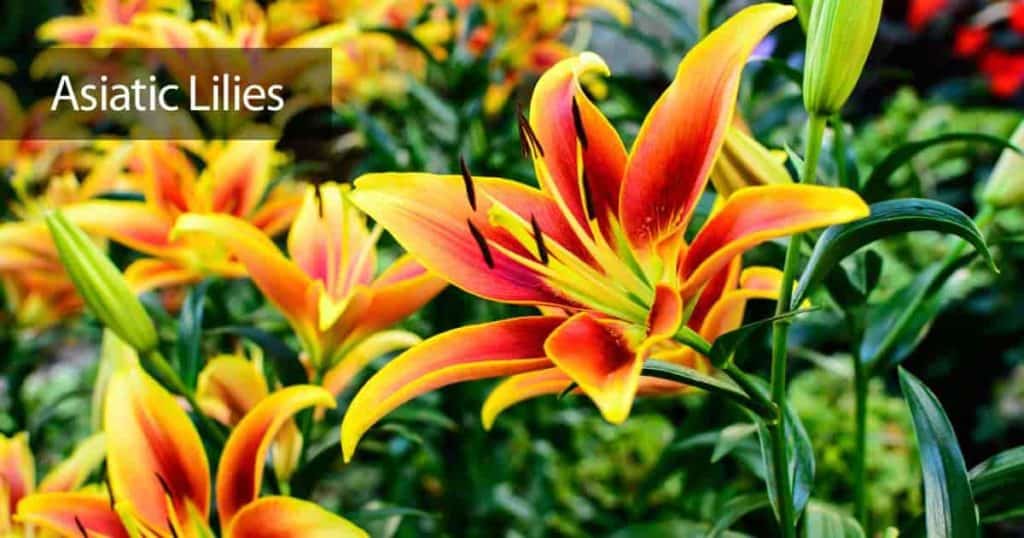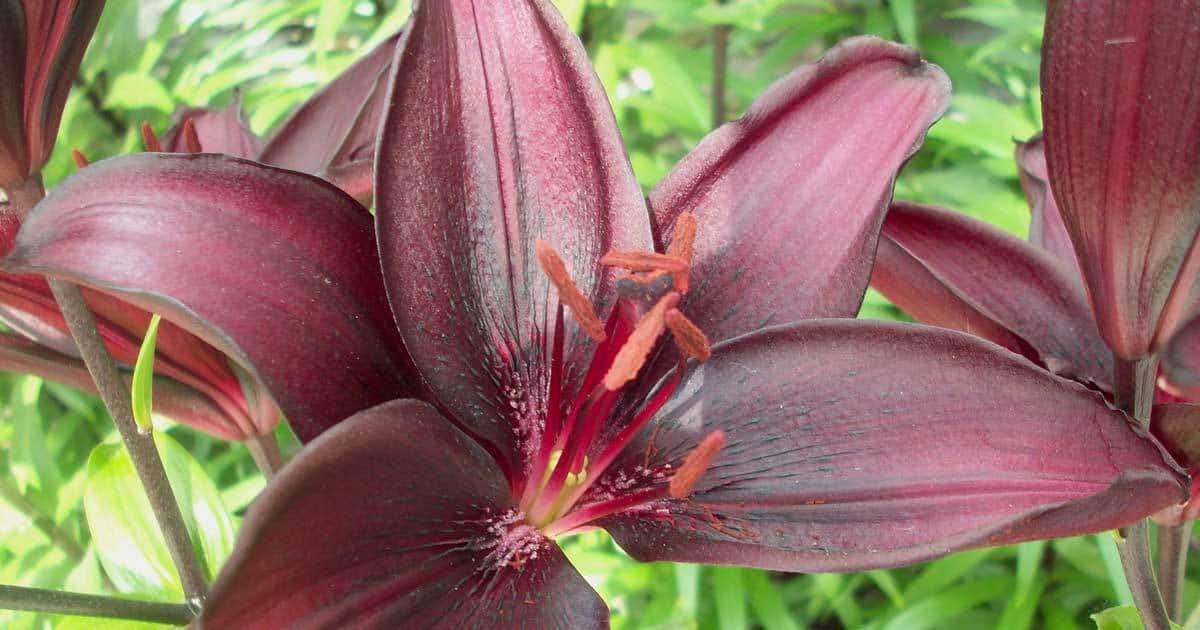The Asiatic lily (Lilium asiatica) makes a perfect plant for landscape design. When planted correctly, one of the hardiest and most popular types of lilies grown, this true lily produces long-lasting flowers.
Beginners new to planting bulbs find Asian lilies among the easiest of all lilies to play with.

They are the first lilies of the season to flower (early summer), and they multiply fast.
In this article, we’ll delve into the deep history of Asiatic lilies and proper Asiatic lilies care.
Deep History Of Asian Lily Flowers From Ancient Egypt To China
The history of the Asiatic lilies runs deep. Painted flowers of the Asian lily flowers were found adorning the walls of ancient Egyptian pyramids.
Chinese paintings with the lily found their way into the power circle of Louis XIV.
Oriental Lily VS Asiatic Hybrid Lilies
The Oriental hybrids share a number of features with the Asiatic hybrid lily.
However, they also possess distinct differences, and no one should see them as the same. A few of their dissimilarities include fragrance, size, and bloom color.
How Big Are Asiatic Lily Bulbs?
The bulbs of Asian lily flowers appear large – 5″ to 6″ inches across – generally white along with a tint of pink.

The bulb color plays no part in flower color. Lily bulbs, when harvested, often look pinkish after exposure to direct sunlight.
Asiatic Lily Quick Care Tips
- Botanical Tips: Botanical Name: Lilium asiaticum
- Common Name(s): Asiatic Lily
- Synonyms: None
- Family & Origin: Liliaceae family, native to Asia
- Growability: Easy to grow
- Grow Zone: USDA zones 4-9
- Size: 2-4′ feet tall, 1-2′ feet wide
- Flowering: Summer
- Light: Full sun to partial shade
- Humidity: Average humidity
- Temperature: Hardy in cold temperatures
- Soil: Well-draining, fertile soil
- Water: Regular watering, but avoid overwatering
- Fertilizer: Fertilize in spring and summer with a balanced fertilizer
- Pests & Diseases: Aphids, spider mites, and botrytis blight can be a problem
- Propagation: Division of bulbs in fall or early spring
- Plant Uses: Garden beds, borders, and cut flowers
The large bulbs store a lot of food, giving them plenty of flower power in the late spring, even with sub-par soil, water, and slow-release fertilizer as well, or feed in early spring with fish emulsion, worm castings, compost tea, or nitrogen plant food.

Asiatic Lily Care: Planting And Growing Asian Lilies
As stated earlier, Asian lily flower hybrids are the hardiest of all the lily hybrids. They flower fast each season and multiply quickly, making them perfect for beginners.
This hybrid lily comes in a wide range of colors, from red, pink, yellow, orange, white, and all other shades of bloom and color combinations except blue.
Plants provide a long season of bloom (up to 1 month), with flowers facing mostly upward, and some provide a very light scent on warm, windless days.
How To Plant Asian Lily Bulbs
Plant Asian lily flower bulbs in early spring or fall before frost in fertile, well-drained soil. This allows the plants to develop a good root system.
Adding organic matter like peat moss will help improve the soil.
When you plant lilies, place them 12″ to 18″ inches apart and at a planting depth of 4″ to 6″ inches in full sun.

A location receiving morning or late afternoon sun with six hours of sunlight minimum is preferable. Asian lilies like slightly acidic (6.5 pH.) soil.
When you receive fresh bulbs, plant them as soon as possible to keep them from drying out.
For a nicer look, place three or more lily bulbs that will eventually multiply into groupings.
Plant them among other flowers to provide the bulbs with partial shade. A bulb planter comes in handy to make a hole at just the right depth.
You can also plant Asiatic lily bulbs in containers in winter to bloom the following spring.
When to plant Asian lily bulbs?
Daylilies should be planted in the North in the spring so they have plenty of time to establish themselves before winter.
However, because daylilies are such hardy plants, they may often be planted anytime from spring through October in the North.

Tips For Watering Your Lily Bulbs
The best Asian lily flower care will have bulbs planted with good drainage but not dry soil. Asiatics need 1 or 2 inches of water per week.
During hot and dry weather, the lilies may need supplemental watering to ensure the root zone stays well moistened. (A drip hose is a great option.) The soil should remain moist and not soggy.
As a guide, water the lilies when the top 1 inch of soil below the surface becomes dry, which will provide the plant with the needed moisture for them to thrive.
How To Fertilize Asian Lilies
A light ring of 5-10-10 fertilizer around the lilies, mixed into the topsoil, provides the nutrients and nourishment required for Asian lily plants to thrive.

This type of fertilizer supplies phosphorus and other nutrients needed for large and healthy blooms.
Related Reading:
- Fertilizing Lilies – When & How Much
- Foxtail Lily (Eremurus lilies) flower spikes 8′ to 10′ feet tall
Apply the fertilizer once the lilies begin to grow each spring, following the application rate directions on the fertilizer bag.
Generally, these lilies do not require frequent fertilizing.
When buds appear on the Asian lily plant, feed with a high phosphorus food or bone meal to make blooms bigger and last longer.
Propagating Asiatic Lilies
Propagate Asian lily plants from stem bulblets, bulb scales, stem bulbils, and bulb division. The fastest way comes from dividing plump bulbs.
Pull them apart and plant them separately.
The video below shows how to propagate lily bulbs by ‘Scaling.”
When And How To Deadhead Lilium Asiatic
Deadheading the blooms as soon as the petals drop improves the appearance but also prevents the plant from using up its energy on seed development.
How to prune lily asiatic?
DO NOT prune the foliage, however, until it dies off naturally during fall. The leaves work gathering energy from the sun to store in the bulbs for the next season’s bloom.
How To Care For Asiatic Lily Bulbs After Blooming – Mulching and Lilium Asiatic Winter Care
Once the foliage dies back naturally, cut the dead foliage to the ground.
Add a 4″ – 6″ inch layer of mulch – straw or leaf mold – to provide the bulbs with protection during winter.

This helps maintain soil temperature and prevent heaving.
Remove the mulch during spring after all danger of the frost passes. This will give room for new growth to appear.
A 2″ – inch layer of bark mulch applied after removing the winter mulch helps to preserve soil moisture and prevents weeds.
Lilium Asiatic Pests And Diseases
Asiatic lilies find themselves susceptible to fungal infection and aphids.
To get rid of aphids on Asian lilies and make sure your plants remain aphid-free, use neem spray oil insecticide, summer oil, or Malathion.
Once the plants are blooming, it is beneficial to apply preventative fungicide applications using chemicals that are effective at controlling Botrytis.

These are examples of fungicides such as Green Guard, bravo, or a baking soda fungus spray by mixing 1 tablespoon of baking soda in two liters of warm water for fungal infection.
NOTE: Asiatic hybrids and species along with Oriental lilies may experience attacks from the destructive red lily beetle (Lilioceris lilii), which feeds almost exclusively on true lilies species (Lilium spp.).
Asiatic Uses In The Home And Garden
The stems of Asian lily plants make nice-cut flowers for use in floral arrangements. When the buds open, the blooms last for several days up to several weeks.
Grow them as ground covers or in mixed perennial garden borders alongside other woody shrubs and flowering perennials.

They also make wonderful potted specimens.
Cat Caution
Keep cats away from your lily bed as they like to lay in them, and they can break the stems and ruin the plant.
Summary
The Asian lily plant could be called the “dream lily” of a home gardener.
How much sun do lilies need?
Give them good, rich soil, lots of sunshine, and water occasionally, and provide a little fertilizer, and they do the rest.

When do Asiatic lilies bloom? Do Asian lily flowers bloom all in late summer?
During the bloom, the time for most types of this summer flower bulb is late May or June, where the bulbs produce an abundance of 3 to 12 blooms for cut flower use in a wide range of colors.
Don’t forget to give “other” Lilium Asiatic varieties a try, such as the white and orange Asiatic lily flower.
All of them are easy to grow and also give gardens lots of colorful blooms to enjoy.
More on Lilies For Your Garden
Popular ‘Stargazer Lily’: While the Asian Lily plant is beautiful, the Stargazer flower is also a popular choice among lily enthusiasts.
